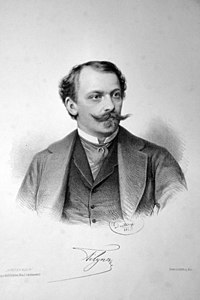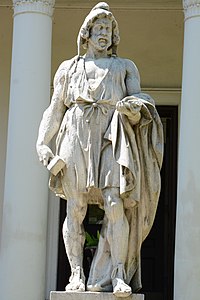You can help expand this article with text translated from the corresponding article in German. (November 2020) Click for important translation instructions.
|


Viktor Oskar Tilgner (25 October 1844 in Pressburg – 16 April 1896 in Vienna) was an Austrian sculptor and medailleur.
Life
He was the son of Captain Carl Tilgner. The family moved to Vienna when he was a child. His talent was recognized early by the sculptor Franz Schönthaler [de], who became his first teacher. Then, at the Academy of Fine Arts, he studied under Franz Bauer and Josef Gasser. Later, he was attracted to engraving and worked with the medailleur Joseph Daniel Böhm [de]. One of Tilgner's student's was German sculptor John Walz.
He belonged to the circle of artists around Count Karol Lanckoroński. During the World Exhibition of 1873, he met the French sculptor Gustave Deloye, who strongly influenced his work. The following year, he took a trip to Italy with Hans Makart, whose "realistic academicism" also influenced Tilgner's style. For the last twenty years of his life, he had a large studio in what was originally a greenhouse at the Palais Schwarzenberg
Despite a long-standing heart condition and recurring chest pain, he spent a strenuous day working on his Mozart monument, to get it ready on schedule. He died of a heart attack the next morning. Often considered to be his greatest work, the monument was unveiled a few days after his death. The bulk of his estate was bequeathed to his hometown and is now on display at the Bratislava City Gallery.
Selected major works
- Statue of Leopold V, Duke of Austria at the Heeresgeschichtliches Museum
- Statue of Peter Paul Rubens at the Künstlerhaus
- Statue of Peter Paul Rubens at the Telfair Academy of Arts and Sciences, Savannah, Georgia
- Statue of Raphael at the Telfair Academy of Arts and Sciences, Savannah, Georgia
- Statues at the Kunsthistorisches Museum: Christian Daniel Rauch, Peter von Cornelius and Moritz von Schwind.
- Statues at the Naturhistorisches Museum: Alexander von Humboldt, Leopold von Buch, Isaac Newton and Carl Linnaeus.
- Statues at the Austrian Parliament building: Archimedes, Marcus Terentius Varro, Homer and Phidias.
- Statues at the Telfair Academy building: Phidias, Raphael and Rembrandt
- Figures at the Burgtheater: Don Juan, Phaidra, Falstaff, Hanswurst, William Shakespeare, Pedro Calderón de la Barca, Molière, Gotthold Ephraim Lessing, Johann Wolfgang von Goethe, Friedrich Schiller, Friedrich Hebbel, Franz Grillparzer and Karl Felix Halm.
- Monument for Josef Werndl, Steyr
- Monument for Anton Bruckner in the Stadtpark. Due to vandalism, the female figure was removed and replaced with a simple pedestal.
- Monument for Johann Nepomuk Hummel, Bratislava
- Monument for Dr Johann Nepomuk Prix, Wiener Zentralfriedhof
- Monument for Franz Liszt, Ödenburg
-
 Peter Paul Rubens
Peter Paul Rubens
-
 Hummel Monument
Hummel Monument
-
 Werndl Monument
Werndl Monument
-
Bruckner Monument, original version
-
 Carl Linnaeus
Carl Linnaeus
-
 Dr Johann Nepomuk Prix Monument
Dr Johann Nepomuk Prix Monument
-
 Phidias
Phidias
References
- ^ Fritz Pollak. (1908), "Tilgner, Viktor Oskar", Allgemeine Deutsche Biographie (in German), vol. 54, Leipzig: Duncker & Humblot, pp. 703–705
- The Art League Publishing Association (1905). The Artists Year Book. p. 212.
- Ludwig Hevesi: Victor Tilgners ausgewählte Werke. Löwy, Vienna, 1897. (11 pages of text and 72 collotypes)
- ^ † Victor Tilgner (1844–1896). In: Neue Freie Presse, 17 April 1896, p. 05 (Online at ANNO)Template:ANNO/Maintenance/nfp.
- Phidias from SIRIS.
- Raphael from SIRIS.
- Rembrandt from SIRIS.
Further reading
- Gerhardt Kapner: Ringstraßendenkmäler. In: Renate Wagner-Rieger, Die Wiener Ringstraße. Bild einer Epoche. Die Erweiterung der Inneren Stadt Wien unter Kaiser Franz Joseph. Vol.9,1. Steiner, Wiesbaden 1973,
- Maria Pötzl-Malikova: Die Plastik der Ringstraße. Künstlerische Entwicklung 1890–1918. In: Renate Wagner-Rieger, Die Wiener Ringstraße. Bild einer Epoche. Die Erweiterung der Inneren Stadt Wien unter Kaiser Franz Joseph. Vol.9,2. Steiner, Wiesbaden 1976, ISBN 3-515-02391-7.
- Walter Krause: Die Plastik der Ringstraße von der Spätromantik bis zur Wende um 1900. In: Renate Wagner-Rieger: Die Wiener Ringstraße. Bild einer Epoche. Die Erweiterung der Inneren Stadt Wien unter Kaiser Franz Joseph. Vol.9,3. Steiner, Wiesbaden 1980, ISBN 3-515-03288-6.
- Contribution by Walter Krause in: Jane Turner: The Dictionary of Art. Vol.30: Summonte to Tinne. Grove, New York 1996, ISBN 1-884446-00-0, pgs.888–890.
External links
- Feuilleton. Victor Tilgner. In: Neue Freie Presse, 19 April 1896, p. 01 (Online at ANNO)Template:ANNO/Maintenance/nfp.
- Victor Tilgner. In: Der Architekt, Year 1896, p. 20 (Hauptteil). (Online bei ANNO)Template:ANNO/Maintenance/arc.
- Bundesdenkmalamt Österreich: Hauptwerk von Viktor Tilgner gerettet. Wiener Zentralfriedhof. Allegorie der Bildhauerei
- Ludwig Hevesi: Obituary in Wiener Totentanz online